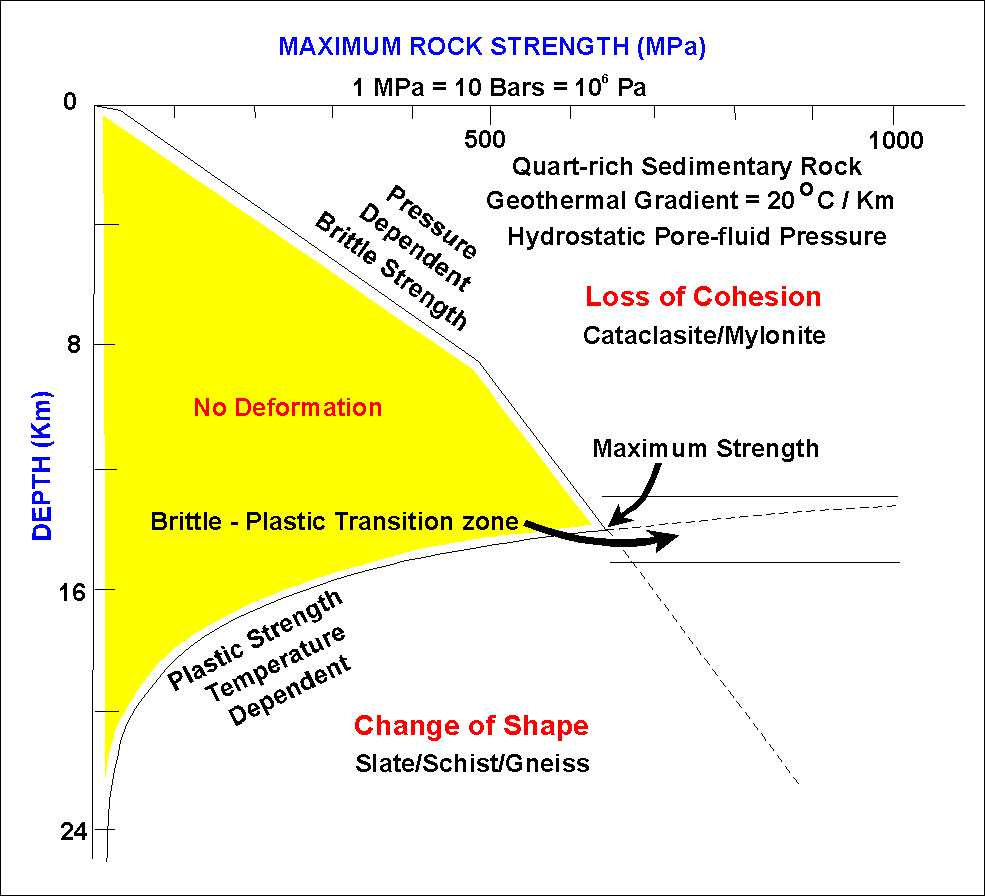
Under near surface conditions, rocks may become crushed to form tectonic breccias or cataclasites, whereas at greater depths mineral grains in in course grained rocks may undergo a process of polygonization involving the breakdown of large grains into an aggregate of smaller grains. Where the grain size reduction takes place in shear zones, the rocks may become extremely fine grained and take on a flow lamination. Such rocks are known as mylonites; and relict grains of the original rock material are called porphyroclasts. (Note: large mineral grains that grow in a rock during metamorphism, e.g. garnet, andalusite, staurolite, are known as porphyroblasts.)
At depth however, the mode of deformation changes from brittle mode to ductile, deformation is penetrative, and the structures formed usually involve folding and a component of shear (flattening, change of shape). The change in mode of deformation takes place at a depth of about 12 km. Where deformation has been sufficiently intense to eradicate all primary structural features in the deformed rocks, it is not uncommon to find domains varying in size from kilometres to meters that have suffered minimal deformation. These domains are known as 'shear pods', or in the case of the smaller examples 'tectonic fish', and are very useful because they provide the only means of determining the primary character (protolith) of the deformed rocks.
Geometrically, faults and folds can be described in terms of sets of planes and lines (lineations). Faults are planar surfaces, whereas folds are curviplanar surfaces. Faults commonly exhibit a linear structure in the form of elongated grooves called slickensides, whereas the linear element in a fold would be the locus of points of maximum curvature of the folded surface, usually referred to as the fold axis or hinge line. Folds are bisected by a plane of bilateral symmetry called the axial plane (surface). The plane normal to the fold axis is called the fold profile, whereas planes that cut the fold obliquely are called false fold profiles; on such planes the amplitude of folds is exagerated. Foliation may form under conditions of simple shear (shear cleavage) or of pure shear (flattening cleavage). When both cleavages form at the same time, they are known as C-S cleavages. Such cleavages are useful because they can be used to determine the sense of movement of the rock during the deformation.
The effect of pure shear (flattening) is to induce the crystallization of micas or chlorite with their crystal cleavage planes parallel to the axial planes of the fold. In this way the fold is thinned in a direction normal to the axial plane of the fold and elongated in a direction roughly normal to the fold axis. The parallelism of the micas is exhibited in hand specimens as a planar fabric parallel to the axial planes of folds. The fabric is called the rock cleavage. Minerals such as amphibole may also grow with a preferred crystallographic orientation. If the amphibole crystals have an acicular habit, the rock will exhibit a linear structure.
Large folds commonly have smaller folds on their limbs; these folds have even smaller folds, and so on. Smaller folds on the limbs of higher order folds are called parasitic folds, and the folds on one limb are the mirror image of folds on the opposing limb. Similarly, the angular relationship of the fold limb to the cleavage on one limb of a fold is a mirror image of the relationship on the complementary limb. Knowing the shape of a parasitic fold or the angular relationship of bedding and cleavage allows the structural geologist to predict the nature of a higher order fold structure.
Folds exhibit shape differences according to the degree of pure shear they have suffered. The difference is best seen in the variation of layer thickness as it is traced from the fold limb to the fold axis. In the case of folds that have not been flattened, beds do not change thickness. They are called concentric folds because the curved surfaces of the layers mimic concentric circles. Folds that have been strongly flattened exhibit bed thicknesses that increase from the limb to the axis. If the flattening is such that adjacent surfaces are essentially similar in form (that is, they can be superimposed one on the other) they are called similar folds.